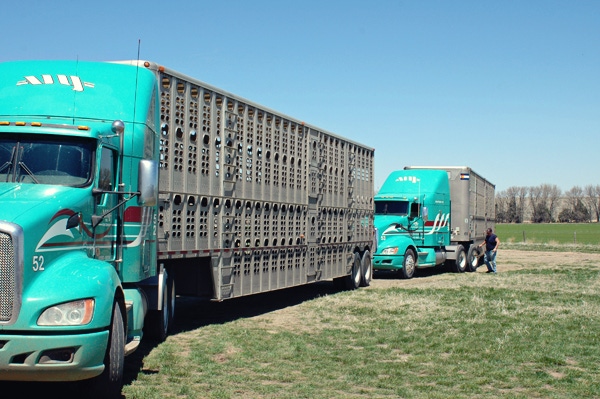Truck Availability Pressures Calf Prices Up North
Trouble finding enough trucks to ship cattle compounded the seasonal influx of fresh-weaned calves in the Northern Plains where calf prices were $5-$10/cwt. lower.
November 1, 2014

“Price levels remain very attractive for yearlings coming off grass with good weighing conditions and strings of long-time weaned, fancy calves,” said analysts with the Agricultural Marketing Service (AMS) Friday. “The other side of the coin is extreme prejudice against un-weaned, fleshy bawlers (high risk) selling, in many cases, in small consignments of mixed quality and color.”
With supplies growing tighter, true yearling prices this week traded steady to firm with instances of $5/cwt. higher, according to AMS. Calves in the Southern Plains and the Southeast traded unevenly steady to $5 higher as calf values increased for winter wheat grazing demand. Calf prices in the Northern Plains traded $5-$10 lower.
Calf supplies dominating receipts up North was part of the price weakness, but so were transportation woes.
“With so many cattle being shipped throughout the trade area, truck availability has become an issue,” explained the AMS reporter on hand for Tuesday’s sale at Miles City Livestock Commission. “Farmer-feeders busy with corn harvest in the Midwest, a large volume of calves being received in feedyards, and not enough trucks are all factors in the pressure seen in the feeder cattle market this week.”
Subscribe now to Cow-Calf Weekly to get the latest industry research and information in your inbox every Friday!
On Thursday, in Nebraska, following the sale at Ogallala Livestock Auction in Nebraska, the reporter explained, “Demand tapered off at sales close as buyers were having a hard time finding trucks to haul their recent buys.”
“Once farmer-feeders get through corn harvest, they should return with an aggressive attitude to buy calves, given the amount of hay and cheaper corn in their bins,” AMS analysts say. “The big question this week is whether there is additional upside to the fed cattle market after last week’s record high of $170/cwt.”
At least for this week, through Friday afternoon’s scant reported trade, the answer in Kansas was live prices $2 lower at $168/cwt.
“Packers have been chasing inventory needs and may have paid all they’re willing to pay to regain their margins,” AMS analysts say.
Packers did receive some margin respite this week in the form of slightly higher wholesale beef values.
Week-to-week, Choice boxed-beef cutout value was $3.79/cwt. higher on Friday afternoon at $251.20/cwt., following a $2.15 decline on the day. Select was $5.92 higher week-to-week, ending Friday at $238.63.
“Steady wholesale beef prices during a time when cattle prices are surging to new records have compressed margins for processors, by some projections,” said John Otte, Penton market analyst Friday. “Wholesale beef prices have risen modestly this week as processors continue to find buyers in domestic and export markets, providing more incentive to secure cattle to fill orders for products.”
Outside markets provided some lift, too, with consumer confidence (Conference Board Consumer Index®) in October higher than the trade expected.
The first estimate of third-quarter GDP (3.5%) was higher than traders expected, too, though government spending comprised a primary part of the increase.
Both the Dow Jones Industrial Average and the S&P 500 closed the week at new record highs, gaining 585 points and 54 points week-to-week, respectively.
“The American consumer has a great variety of competing meats to choose from and is quick to notice when budgets are tight, but the price of gas at its lowest average cost in nearly four years should help consumers budget for competing meats,” AMS analysts say.
“Consumption going forward is a concern,” Otte says. “Hog and pork prices have sunk this fall in anticipation of a wave of supplies coming to market in the months ahead, and are now barely half the cost as cattle and beef. The wider the beef-pork spread, the more incentive consumers have to ‘trade down’ to pork and poultry which are both significantly cheaper than beef.”
In the meantime, thinking of the seasonal market where calf health risk is heavily discounted, AMS analysts note, “Producers can add value to their calves by pre-conditioning with a full vaccination program and weaning them for at least 45 days. One of the widest price gaps in the feeder market is on long-time-weaned, thin, old-crop yearlings weighing 650 lbs. and un-weaned, fleshy, bawling calves at the same weight. There can easily be $25-$30/cwt. difference in price.”
“Even though volatility seems to be ever present in the feeder cattle market, negative price risk is rather minimal at this time,” says Andrew P. Griffith, University of Tennessee agricultural economist, in his weekly market comments. “Cattle prices have climbed more than 70% the past 15 months, and there is little to no indication of prices falling in the near future. Therefore, returns to the investment in cattle production are expected to remain strong the next couple of years. The one concern many producers have with volatility is selling cattle at a low point during a volatile market. However, cash price volatility has been much lower than volatility in the futures market.”
Griffith notes that volatility and risk are different. “Volatility is how quickly the market is increasing and decreasing, while risk is more associated with the long-term direction of the market.”
You might also enjoy:
Producers Must Act Now To Save Their Beef Checkoff Program
4 Tips For Eliminating Weeds This Fall
About the Author(s)
You May Also Like




.png?width=300&auto=webp&quality=80&disable=upscale)
